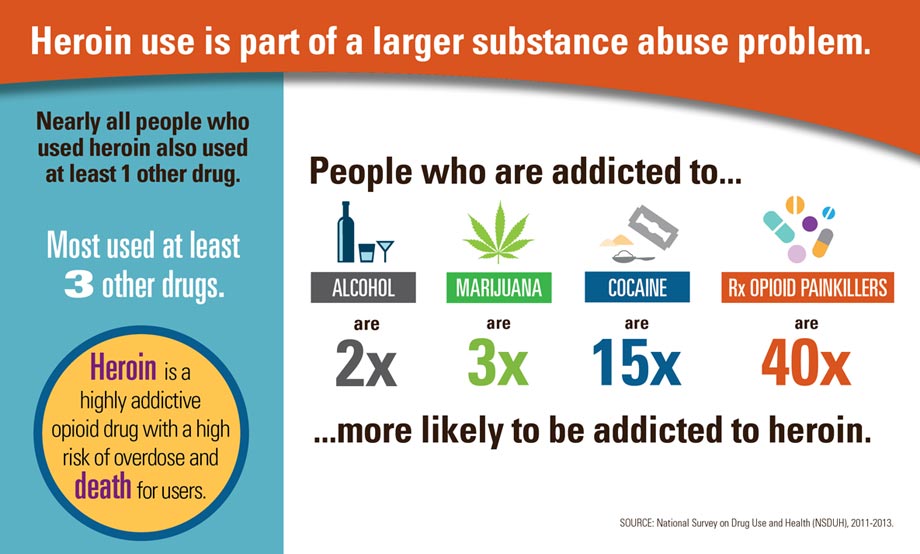Heroin and Opioids
Help Relieve Pain, But Often Cause More Serious Problems
 When properly administered, opioids can help an individual better manage their physical pain. But far too often these drugs cause more problems than they solve.
When properly administered, opioids can help an individual better manage their physical pain. But far too often these drugs cause more problems than they solve.
Consider these alarming statistics:
- Since 1999, the number of overdose deaths involving opioids (including prescription opioids and heroin) quadrupled in the United States.1
- 2 million Americans over age 12 have had a diagnosis of substance abuse involving prescription pain medication; approximately 591,000 involved heroin.2
- Since 2004, 6,000 people have died from opioid overdose in New Jersey.3
 Studies show that the powerful impact of opioids centers on the drug’s ability to change the brain’s chemistry in ways that cause an individual to pursue the drugs to re-create the pleasure feelings or reduce pain. Far too often this leads to a chemical addiction.4
Studies show that the powerful impact of opioids centers on the drug’s ability to change the brain’s chemistry in ways that cause an individual to pursue the drugs to re-create the pleasure feelings or reduce pain. Far too often this leads to a chemical addiction.4
“When properly prescribed and taken for a short amount of time, opioid pain relievers are effective and generally safe,” said P-CASA’s Coalition Member. “However, because these drugs can produce such an enjoyable feeling—often described as ‘euphoric’, they can lead to addiction, overdose, and even death.”
Is heroin really an issue?
Yes! Heroin is a highly addictive opioid drug made from morphine, a psychoactive (mind-altering) substance that is extracted from the resin of the seed pod of the opium poppy plant. Heroin’s color and look depend on how it is made and what else it may be mixed with. It can be a white or brown powder or a black, sticky substance called “black tar heroin”.5
 Heroin is mixed with water and injected with a needle. It can also be sniffed, smoked, or snorted. Users sometimes combine it with other drugs, such as alcohol or cocaine (a “speedball”), which can be particularly dangerous and raise the risk of overdose.
Heroin is mixed with water and injected with a needle. It can also be sniffed, smoked, or snorted. Users sometimes combine it with other drugs, such as alcohol or cocaine (a “speedball”), which can be particularly dangerous and raise the risk of overdose.
Paterson Youth and Heroin
As a part of our efforts to understand and reduce the use of opioids in Paterson, P-CASA collected local level data to assess the impact of prescription drug use among Paterson youth. The findings illustrate an underlying issue that influences prescription drug usage among adolescents and more awareness of this problem is needed:
- Paterson youth who admitted to taking prescription drugs were 54 times more likely to try heroin.
- Youth that admitted to having drank alcohol were 2.5 times more likely to take prescription drugs without their doctor prescribing it to them.
- Paterson youth who admitted to attempting suicide in the last 12 months were also twice as likely to use prescription drugs.
What are Opioids?
Opioids are a class of drugs that are typically prescribed to relieve pain, but illegal opioids—like heroin—are also available.
Common prescription opioids include:
- Oxycodone (also known as OxyContin®)
- Hydrocodone (also known as Vicodin®)
- Codeine
- Morphine
- Fentanyl
Nearly 80 percent of people in the United States who have used heroin report having first misused prescription opioids.
P-CASA is working to build a better Paterson.
P-CASA understands the importance of reducing access to opioids among Paterson adolescents. With that in mind, we are:
- Developing social media and marketing campaigns to spread awareness about prescription drug and heroin use in Paterson.
- Connecting Paterson youth to school based and community based mental health services that can aid in reducing the likelihood of misusing prescription drugs and heroin.
For more information about e-cigarettes and youth, click here.
References:
- CDC. Wide-ranging online data for epidemiologic research (WONDER). Atlanta, GA: CDC, National Center for Health Statistics; 2016. Available at http://wonder.cdc.gov.
- Fentanyl: The Next Wave of the Opioid Crisis. (2017). Subcommittee on Oversight and Investigations, Committee on Energy and Commerce, United States House of Representatives, 115th Congress, First Session. Retrieved from: https://www.hsdl.org/?view&did=801449
- Overdose Prevention Campaign: NJ overdose statistics. Retrieved from: http://www.drugpolicy.org/resource/overdose-prevention-campaign-nj-overdose-statistics
- Kosten, T. R., & George, T. P. (2002). The Neurobiology of Opioid Dependence: Implications for Treatment. Science & Practice Perspectives, 1(1), 13–20.
